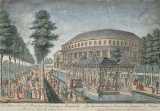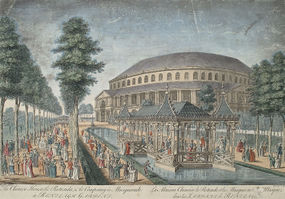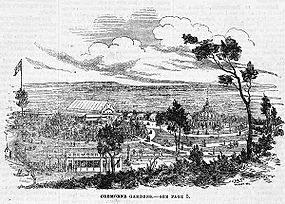
Pleasure gardens
Encyclopedia


Garden
A garden is a planned space, usually outdoors, set aside for the display, cultivation, and enjoyment of plants and other forms of nature. The garden can incorporate both natural and man-made materials. The most common form today is known as a residential garden, but the term garden has...
that is open to the public
Public
In public relations and communication science, publics are groups of individuals, and the public is the totality of such groupings. This is a different concept to the sociological concept of the Öffentlichkeit or public sphere. The concept of a public has also been defined in political science,...
for recreation
Recreation
Recreation is an activity of leisure, leisure being discretionary time. The "need to do something for recreation" is an essential element of human biology and psychology. Recreational activities are often done for enjoyment, amusement, or pleasure and are considered to be "fun"...
. They differ from other public gardens in that they serve as venues for entertainment, variously featuring concert halls or bandstand
Bandstand
A bandstand is a circular or semicircular structure set in a park, garden, pier, or indoor space, designed to accommodate musical bands performing concerts...
s, ride
Amusement ride
Amusement rides are large mechanical devices that move people to create enjoyment. They are frequently found at amusement parks, traveling carnivals, and funfairs.-Notable types:*Afterburner*Ali Baba*Balloon Race*Booster...
s, zoo
Zoo
A zoological garden, zoological park, menagerie, or zoo is a facility in which animals are confined within enclosures, displayed to the public, and in which they may also be bred....
s, and menagerie
Menagerie
A menagerie is/was a form of keeping common and exotic animals in captivity that preceded the modern zoological garden. The term was first used in seventeenth century France in reference to the management of household or domestic stock. Later, it came to be used primarily in reference to...
s.
History
Public pleasure gardens have existed for many centuries. In Ancient RomeAncient Rome
Ancient Rome was a thriving civilization that grew on the Italian Peninsula as early as the 8th century BC. Located along the Mediterranean Sea and centered on the city of Rome, it expanded to one of the largest empires in the ancient world....
, the landscaped
Landscaping
Landscaping refers to any activity that modifies the visible features of an area of land, including:# living elements, such as flora or fauna; or what is commonly referred to as gardening, the art and craft of growing plants with a goal of creating a beautiful environment within the landscape.#...
Gardens of Sallust
Gardens of Sallust
The Gardens of Sallust were Roman gardens developed by the Roman historian Sallust in the 1st century BC. The landscaped pleasure gardens occupied a large area in the northwestern sector of Rome, in what would become Region VI, between the Pincian and Quirinal hills, near the Via Salaria and later...
(Horti Sallustiani) were developed as a private garden by the historian Sallust
Sallust
Gaius Sallustius Crispus, generally known simply as Sallust , a Roman historian, belonged to a well-known plebeian family, and was born at Amiternum in the country of the Sabines...
. The gardens were acquired by the Roman Emperor
Roman Emperor
The Roman emperor was the ruler of the Roman State during the imperial period . The Romans had no single term for the office although at any given time, a given title was associated with the emperor...
Tiberius
Tiberius
Tiberius , was Roman Emperor from 14 AD to 37 AD. Tiberius was by birth a Claudian, son of Tiberius Claudius Nero and Livia Drusilla. His mother divorced Nero and married Augustus in 39 BC, making him a step-son of Octavian...
for public use. Containing many pavilions, a temple
Temple
A temple is a structure reserved for religious or spiritual activities, such as prayer and sacrifice, or analogous rites. A templum constituted a sacred precinct as defined by a priest, or augur. It has the same root as the word "template," a plan in preparation of the building that was marked out...
to Venus
Venus
Venus is the second planet from the Sun, orbiting it every 224.7 Earth days. The planet is named after Venus, the Roman goddess of love and beauty. After the Moon, it is the brightest natural object in the night sky, reaching an apparent magnitude of −4.6, bright enough to cast shadows...
, and monumental sculpture
Monumental sculpture
The term monumental sculpture is often used in art history and criticism, but not always consistently. It combines two concepts, one of function, and one of size, and may include an element of a third more subjective concept. It is often used for all sculptures that are large...
s, the gardens were open to the public for centuries.
Many public pleasure gardens were opened in London in the 18th and 19th centuries, including Cremorne Gardens
Cremorne Gardens, London
Cremorne Gardens were popular pleasure gardens by the side of the River Thames in Chelsea, London. They lay between Chelsea Harbour and the end of the King's Road and flourished between 1845 to 1877; today only a vestige survives, on the river at the southern end of Cheyne Walk.-History:Originally...
, Cuper's Gardens
Cuper's Gardens
Cuper's Gardens were an 18th century tea garden on the south side of the River Thames in Lambeth, London, looking over to Somerset House near where Waterloo Bridge is located .The gardens opened in the 1680s and were named after the original proprietor, Abraham Boydell Cuper, the...
, Marylebone Gardens
Marylebone Gardens
Marylebone or Marybone Gardens was a London pleasure garden sited in the grounds of the old manor house of Marylebone and frequented from the mid-17th century, when Marylebone was a village separated from London by fields and market gardens, to the third quarter of the 18th century...
, Ranelagh Gardens
Ranelagh Gardens
Ranelagh Gardens were public pleasure gardens located in Chelsea, then just outside London, England in the 18th century.-History:The Ranelagh Gardens were so called because they occupied the site of Ranelagh House, built in 1688-89 by the first Earl of Ranelagh, Treasurer of Chelsea Hospital ,...
, Royal Surrey Gardens
Royal Surrey Gardens
Royal Surrey Gardens were pleasure gardens in Kennington, London in the Victorian period, slightly east of The Oval. The gardens occupied about to the east side of Kennington Road, including a lake of about . It was the site of Surrey Zoological Gardens and Surrey Music Hall.The gardens were the...
and Vauxhall Gardens
Vauxhall Gardens
Vauxhall Gardens was a pleasure garden, one of the leading venues for public entertainment in London, England from the mid 17th century to the mid 19th century. Originally known as New Spring Gardens, the site was believed to have opened before the Restoration of 1660 with the first mention being...
. Many contained large concert halls, or hosted promenade concert
Promenade concert
See The PromsAlthough the term Promenade Concert is normally associated today with the series of concerts founded in 1895 by Robert Newman and the conductor Henry Wood – a festival known today as the BBC Proms – the term originally referred to concerts in the pleasure gardens of London where the...
s; some lesser discussed pleasure gardens were home to haberdasheries and harems. A smaller version of a pleasure garden is a tea garden
Tea garden
Tea garden may refer to:* Roji, gardens surrounding Japanese tea houses and which form part of the architecture associated with Japanese tea ceremony* Tea plantations, where tea bushes are cultivated...
, where visitors may drink tea
Tea
Tea is an aromatic beverage prepared by adding cured leaves of the Camellia sinensis plant to hot water. The term also refers to the plant itself. After water, tea is the most widely consumed beverage in the world...
and stroll.
The pleasure garden also forms one of the six parts of the 18th century "perfect garden" , the others being the kitchen garden
Kitchen garden
The traditional kitchen garden, also known as a potager, is a space separate from the rest of the residential garden - the ornamental plants and lawn areas...
, an orchard
Orchard
An orchard is an intentional planting of trees or shrubs that is maintained for food production. Orchards comprise fruit or nut-producing trees which are grown for commercial production. Orchards are also sometimes a feature of large gardens, where they serve an aesthetic as well as a productive...
, a park
Park
A park is a protected area, in its natural or semi-natural state, or planted, and set aside for human recreation and enjoyment, or for the protection of wildlife or natural habitats. It may consist of rocks, soil, water, flora and fauna and grass areas. Many parks are legally protected by...
, an orangery
Orangery
An orangery was a building in the grounds of fashionable residences from the 17th to the 19th centuries and given a classicising architectural form. The orangery was similar to a greenhouse or conservatory...
or greenhouse
Greenhouse
A greenhouse is a building in which plants are grown. These structures range in size from small sheds to very large buildings...
, and a menagerie
Menagerie
A menagerie is/was a form of keeping common and exotic animals in captivity that preceded the modern zoological garden. The term was first used in seventeenth century France in reference to the management of household or domestic stock. Later, it came to be used primarily in reference to...
.
Contemporary
Modern versions of public pleasure gardens may be or contain an amusement parkAmusement park
thumb|Cinderella Castle in [[Magic Kingdom]], [[Disney World]]Amusement and theme parks are terms for a group of entertainment attractions and rides and other events in a location for the enjoyment of large numbers of people...
, such as Tivoli Gardens in Copenhagen
Copenhagen
Copenhagen is the capital and largest city of Denmark, with an urban population of 1,199,224 and a metropolitan population of 1,930,260 . With the completion of the transnational Øresund Bridge in 2000, Copenhagen has become the centre of the increasingly integrating Øresund Region...
or the Bisan City pleasure garden in Gaza
Gaza
Gaza , also referred to as Gaza City, is a Palestinian city in the Gaza Strip, with a population of about 450,000, making it the largest city in the Palestinian territories.Inhabited since at least the 15th century BC,...
.
Further reading
- Wroth, A. E. & W. W. The London Pleasure Gardens of the Eighteenth Century (MacMIllan, 1896).

